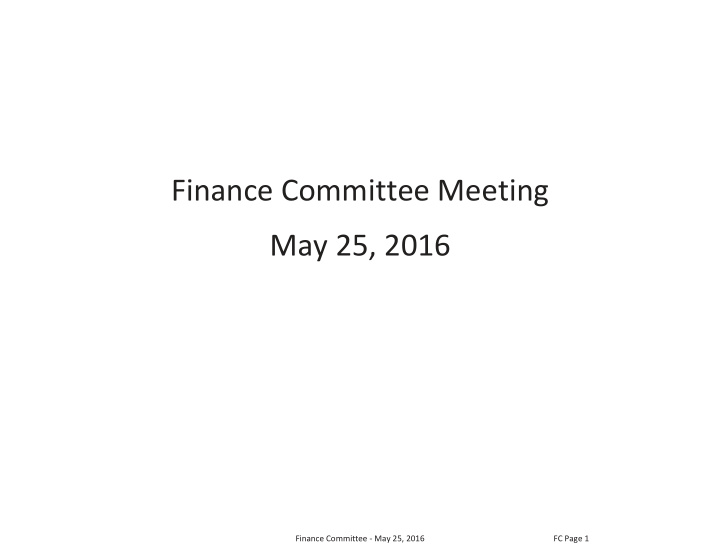



Finance Committee Meeting May 25, 2016 Finance Committee - May 25, 2016 FC Page 1
Pennsylvania Legislator’s Municipal Deskbook, Fourth Edition (2014) Pages 137 through 141 Finance Committee - May 25, 2016 FC Page 2
������������������������������������������������������������������� ������ ������������������������������ ��������������� ����������������� ���������� Real property taxes have been and continue to be an important source of local revenue for counties, municipalities, and school districts. In 2009, $14.5 billion dollars in property tax revenue was collected by local taxing districts—$10.7 billion by school districts, $1.9 billion by counties, $1.5 billion by taxation purposes in cities of the third class. 6 $ municipalities, and $0.4 billion by Philadelphia. 1 The property tax is not levied at the state level in Pennsylvania. The Consolidated County Assessment law 2 (hereinafter referred to the assessment law) governs the real estate assess- ment process in counties of the second class A through the eighth class. 3 Philadelphia 4 and Allegheny 5 Counties primarily ���������������������������� are subject to distinctive statutory provisions regarding the assessment of real property, as well as to unique home rule charter and administrative code require- ments. The Third Class City Code sets forth procedures relating to the assessment of real property for 1 The Legislative Budget and Finance Committee, December 11, 2012, office email, citing 2009 data obtained from the Department of Community and Economic Development and the Pennsylvania Department of Education. 2 53 Pa.C.S. § 8801 et seq., <http://www.legis.state.pa.us/WU01/LI/LI/CT/HTM/53/00.088..HTM>. 3 In addition, a school district of the first class A, second class, third class or fourth class is subject to the property tax rate restrictions and anti-windfall limitations delineated in the Taxpayer Relief Act (Act of June 27, 2006, Special Session 1, P.L. 1873, No. 1). 4 “The General County Assessment Law,” Act 155 of 1933 (72 P.S. § 5020-101 et seq.); Related to Taxation; Board of Revision of Taxes, Act 404 of 1939 (72 P.S. § 5341.1 et seq.); 53 Pa.C.S. §§ 8561-8565 (relating to assessments in cities and counties of the first class). 5 “The General County Assessment Law”; Second Class County Assessment Law, Act 294 of 1939 (72 P.S. § 5452.1 et seq.); Second Class County Code, Act 230 of 1953 (16 P.S. § 3101 et seq.). 6 “The Third Class City Code,” Act 317 of 1931, § 2522 (53 P.S. § 2522). ������������������������������ � ��������������������������� �������� Finance Committee - May 25, 2016 FC Page 3
���������������������������������������������������������������� ��������������� “Base year.” The year upon which real property market values are based for the most recent countywide revision of assessment of real property or other prior year upon which the market value of all real prop- erty of the county is based for assessment purposes. Real property market values shall be equalized within the county and any changes by the board 7 shall be expressed in terms of base-year values. 8 “Common level ratio.” The ratio of assessed value to current market value used generally in the county and published by the State Tax Equalization Board on or before July 1 of the year prior to the tax year on appeal before the board under the act of June 27, 1947 (P.L.1046, No.447), referred to as the State Tax Equalization Board Law. 9 “Established predetermined ratio.” The ratio of assessed value to market value established by the board of county commissioners and uniformly applied in determining assessed value in any year. 10 “STEB.” The State Tax Equalization Board. ����������� Pennsylvania has a constitutional requirement for uniformity of taxation. 11 Since 1909, the courts have t on. 1 Pennsyl y v l ania has a consti t tuti t onal requirement fo f r unifo f rmity t of taxati held that real estate is a taxable subject of one class and taxes must be uniform upon the same class of j p subjects. 12 A uniform assessment rate means that all properties in a county, whether residential, commer- j A unifo f rm assessment rate means that all properti p p t es in a county t , whether residenti y t al, commer- cial, or industrial, will be assessed at the same ratio of assessed value to market value. The Pennsylvania cial, or industrial, wi w ll be assessed at the same rati t o of assessed value to market value. Supreme Court stated: . . . the principle of uniformity is a constitutional mandate to the courts, to the legislature, and to the taxing authorities, in the levy and assessment of taxes which cannot be disre- garded. The purpose of requiring all tax laws to be uniform is to produce equality of taxation. Absolute equality is difficult of attainment, and approximate equality is all that can rea- sonably be expected. Hence it has been held that where there is substantial uniformity the constitutional requirement has been met. . . . 13 7 “‘Board.’ The board of assessment appeals or the board of assessment revision established in accordance with section 8851 (relating to board of assessment appeals and board of assessment revision). The term, when used in conjunction with hearing and determining appeals from assessments, shall include an auxiliary appeal board.” 53 Pa.C.S. § 8802. 8 53 Pa.C.S. § 8802. 9 Id . 10 Id . 11 “All taxes shall be uniform, upon the same class of subjects, within the territorial limits of the authority levying the tax, and shall be levied and collected under general laws.” Pa. Const. art. XIII, § 1. 12 Delaware, Lackawanna & Western Railroad Company's Tax Assessment (No. 1) , 73 A. 429 (Pa. 1909). 13 Id. at 430 (citations omitted). �������� Finance Committee - May 25, 2016 FC Page 4
Recommend
More recommend